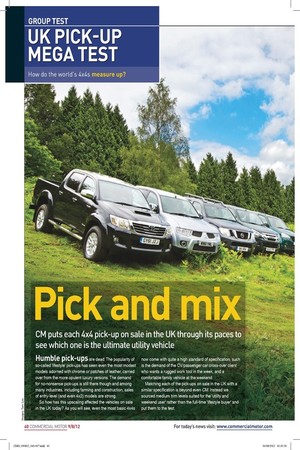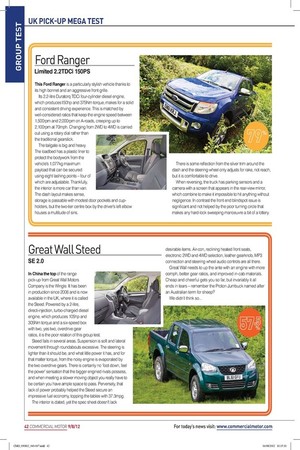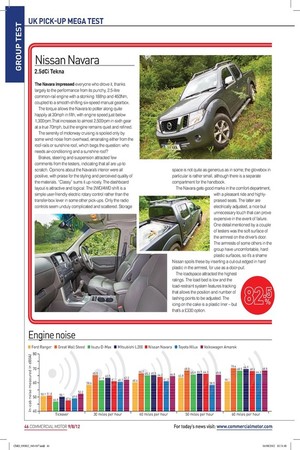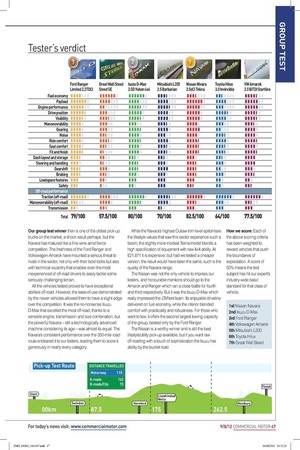Pick and mix
Page 30

Page 32

Page 33

Page 34

Page 35

Page 36

Page 37

If you've noticed an error in this article please click here to report it so we can fix it.
CM puts each 4x4 pick-up on sale in the UK through its paces to see which one is the ultimate utility vehicle
Humble pick-ups are dead. The popularity of so-called ‘lifestyle’ pick-ups has seen even the most modest models adorned with chrome or patches of leather, carried over from the more opulent luxury versions. The demand for no-nonsense pick-ups is still there though and among many industries, including farming and construction, sales of entry-level (and even 4x2) models are strong.
So how has this upscaling affected the vehicles on sale in the UK today? As you will see, even the most basic 4x4s now come with quite a high standard of specification, such is the demand of the CV/passenger car cross-over client who wants a rugged work tool in the week, and a comfortable family vehicle at the weekend.
Matching each of the pick-ups on sale in the UK with a similar specification is beyond even CM. Instead we sourced medium trim levels suited for the ‘utility and weekend user’ rather than the full-time ‘lifestyle buyer’ and put them to the test.
Ford Ranger
Limited 2.2TDCi 150PS
This Ford Ranger is a particularly stylish vehicle thanks to its high bonnet and an aggressive front grille.
Its 2.2-litre Duratorq TDCi four-cylinder diesel engine, which produces150hp and 375Nm torque, makes for a solid and consistent driving experience. This is matched by well-considered ratios that keep the engine speed between 1,500rpm and 2,000rpm on A-roads, creeping up to 2,100rpm at 70mph. Changing from 2WD to 4WD is carried out using a rotary dial rather than the traditional gearstick.
The tailgate is big and heavy.
The loadbed has a plastic liner to protect the bodywork from the vehicle’s 1,077kg maximum payload that can be secured using eight lashing points – four of which are adjustable. Thankfully, the interior is more car than van.
The dash layout makes sense, storage is passable with modest door pockets and cup holders, but the two-tier centre box by the driver’s left elbow houses a multitude of sins. There is some reflection from the silver trim around the dash and the steering wheel only adjusts for rake, not reach, but it is comfortable to drive.
When reversing, the truck has parking sensors and a camera with a screen that appears in the rear-view mirror, which combine to make it impossible to hit anything without negligence. In contrast the front end blindspot issue is significant and not helped by the poor turning circle that makes any hard-lock sweeping manoeuvre a bit of a lottery.
Great WaLL Steed
SE 2.0
In China the top of the range pick-up from Great Wall Motors Company is the Wingle. It has been in production since 2006 and is now available in the UK, where it is called the Steed. Powered by a 2-litre, direct-injection, turbo-charged diesel engine, which produces 105hp and 305Nm torque and a six-speed box with two, yes two, overdrive gear ratios, it is the poor relation of this group test.
Steed fails in several areas. Suspension is soft and lateral movement through roundabouts excessive. The steering is lighter than it should be, and what little power it has, and for that matter torque, from the noisy engine is evaporated by the two overdrive gears. There is certainly no ‘foot down, feel the power’ sensation that the bigger engined rivals possess, and when meeting a slower moving object you really have to be certain you have ample space to pass. Perversely, that lack of power probably helped the Steed secure an impressive fuel economy, topping the tables with 37.3mpg.
The interior is dated, yet the spec sheet doesn’t lack desirable items. Air-con, reclining heated front seats, electronic 2WD and 4WD selection, leather gearknob, MP3 connection and steering wheel audio controls are all there.
Great Wall needs to up the ante with an engine with more oomph, better gear ratios, and improved in-cab materials. Cheap and cheerful gets you so far, but invariably it all ends in tears – remember the Proton Jumbuck named after an Australian term for sheep?
We didn't think so...
Isuzu D-Max
2.5D Yukon 4x4
Isuzu has plans to become number one in the UK utility pick-up market with the replacement for the Rodeo, the new D-Max. Targeting agricultural and construction customers with attractive pricing for entry-level 4x2 and 4x4 vehicles, the D-Max appears to be great value. Base models get air-con, electric windows and six airbags among the standard equipment, while power comes from a 2.5-litre twin turbocharged common-rail diesel engine producing 163hp and 400Nm of torque. It’s a package that appealed to our test team, who scored the D-Max highly for its mechanical components, including engine and comfort. They also found it good off-road due to the wealth of torque and sensible gear ratios.
Commended for its overall visibility, the D-Max feels noticeably smaller than many of the other test vehicles. Although this didn’t reflect in the manoeuvrability scores it received on the road, it did help off-road where the slower speeds and the D-Max’s ability to find traction on wet gradients made it the top performer in the dirt across all three scoring categories.
Testers commented on the ‘superb ride’, ‘wonderful driveline’ and space available to the driver. However, some of the interior plastics were less well received, as was the usefulness of the dash storage and the clarity of the instrument displays. Styling of the interior and exterior was criticised by a few who found it bland, but, on the whole, the panel believed the D-Max to be a formidable all-rounder.
Mitsubishi L200
2.5 Barbarian
Japanese pick-up trucks used to have the market sown up, and with its macho Barbarian trim the L200 was one of the most desirable and distinctive of the old guard. It’s rippled bonnet, angular yet sleek curves and dashes of chrome detailing still look fresh in the line-up and now that it is Euro-5 compliant its 2.5-litre 173hp engine should do the business on paper. On start-up there is vibration through the seats and steering wheel, but once on the move the engine settles, delivering 400Nm of torque from 2,000rpm.
It feels adequate without being exceptional, and must be kept within the sweet spot of 1,800rpm-2,300rpm, but is more than capable of hauling the vehicle, driver and 50% payload up a steep incline on tickover in low range.
With only five gears, the L200’s engine feels more stressed than its rivals as you progress up the gears – a point that was reflected in the overall cabin noise, where the L200 is consistently among the noisiest, especially at a true 70mph where it hums at 2,500rpm. Testers praised the Mitsubishi for its positive gearshift, with a smooth action and ideal positioning, but found the low-range box hard to engage at times and its gearing too short. Aside from a few minor highlights, including its tough interior, the L200 scored average marks in most categories, and is perhaps best summed up by one tester who labelled the L200 as a "workman-like vehicle that does most things competently".
Toyota Hilux
4WD 3.0 Invincible
The Top Gear presenters are well-known for their attempts to destroy a 1988 Toyota Hilux.
Perhaps they would like to try again with a 2012 model?
Most of our criticism centres on the five-speed torque converter automatic transmission. “Positively archaic,” said one driver. The shifts are smooth but there aren't enough of them and as the speed increases the gearbox just hangs onto the ratio, refusing to shift up until around 3,000rpm. The only respite comes when the gearbox hits its long-striding (0.716:1 overdrive) fifth gear, allowing the engine speed to settle around 2,100rpm at 70mph.
Power of 169hp and peak torque of 360Nm are not as much as one might expect from a 3-litre common-rail diesel, and the automatic box spoils what is available. However, the peak torque plateau is wide, stretching from 1,400rpm to 3,200rpm, promising good flexibility. Indeed, the engine pulls quite strongly from 1,400rpm, so it would have been good to exploit that with Toyota’s five-speed manual gearbox. The loadspace lacks any winning features. The load height is higher than most, but there is no lining or protection as standard, while the interior proves that you can’t please everyone. “Fussy instrument markings and too many switch blanks,” said one tester. Others commended the interior's rugged feel. So, what did we like? Steering and handling was judged to be reasonably good, disguising what is quite a bulky vehicle, and the ride comfort was pretty good too, both in terms of the seat and the suspension.
Volkswagen Amarok
2.0 BiTDI Startline
Volkwagen’s first entry into the UK pick-up market since a Golf-based truck in the ‘80s has gone down rather well. It won the International Pick-Up Award in 2010, and is once again a contender for the 2012 title (along with the Ford Ranger, Isuzu D-Max and Great Wall Steed) at Commercial Motor Live later this year.
With a 2-litre engine, the joint smallest capacity of the group, the Amarok could be left behind on power, but thanks to two turbochargers it develops a healthy 161hp, overshadowing the power produced by the single turbo Great Wall 2-litre engine. As well as being more powerful than the Steed, the Amarok engine is also more refined, proving quieter and more flexible throughout the rev range, with peak torque arriving at 1,500rpm.
Ride comfort is particularly good on-road, as is the Amarok’s handling, which is sharp and communicative, linking this enormous-looking truck capably with the road. While on-road performance is exemplary, and off-road traction good, its size makes it less nimble and gauging the landscape harder.
Inside, the Amarok feels car-like with a clear dash and control layout centred around the driver. The numerous storage holes suit a variety of items, and overall quality, fit and finish is of a high standard. Its biggest weakness is its size, and while gadgets such as parking sensors help, there’s no escaping the fact that it feels heavy and vulnerable off-road compared to some of its rivals.
Nissan Navara
2.5dCi Tekna
The Navara impressed everyone who drove it, thanks largely to the performance from its punchy, 2.5-litre common-rail engine with a stonking 188hp and 450Nm, coupled to a smooth-shifting six-speed manual gearbox.
The torque allows the Navara to potter along quite happily at 30mph in fifth, with engine speed just below 1,300rpm.That increases to almost 2,500rpm in sixth gear at a true 70mph, but the engine remains quiet and refined.
The serenity of motorway cruising is spoiled only by some wind noise from overhead, emanating either from the roof-rails or sunshine roof, which begs the question: who needs air-conditioning and a sunshine roof?
Brakes, steering and suspension attracted few comments from the testers, indicating that all are up to scratch. Opinions about the Navara’s interior were all positive, with praise for the styling and perceived quality of the materials. “Classy” sums it up nicely. The dashboard layout is attractive and logical. The 2WD/4WD shift is a simple user-friendly electric rotary control rather than the transfer-box lever in some other pick-ups. Only the radio controls seem unduly complicated and scattered. Storage space is not quite as generous as in some; the glovebox in particular is rather small, although there is a separate compartment for the handbook.
The Navara gets good marks in the comfort department, with a pleasant ride and highlypraised seats. The latter are electrically adjusted, a nice but unnecessary touch that can prove expensive in the event of failure. One detail mentioned by a couple of testers was the soft surface of the armrest on the driver’s door. The armrests of some others in the group have uncomfortable, hard plastic surfaces, so it’s a shame Nissan spoils these by inserting a cut-out edged in hard plastic in the armrest, for use as a door-pull.
The loadspace attracted the highest ratings. The load bed is low and the load-restraint system features tracking that allows the position and number of lashing points to be adjusted. The icing on the cake is a plastic liner – but that’s a £330 option.
Tester’s verdict
Our group test winner then is one of the oldest pick-up trucks on the market, a shock result perhaps, but the Navara has matured like a fine wine amid fierce competition. The freshness of the Ford Ranger and Volkswagen Amarok have mounted a serious threat to rivals in the sector, not only with their bold looks but also with technical wizardry that enables even the most inexperienced of off-road drivers to easily tackle some seriously challenging terrain.
All the vehicles tested proved to have exceptional abilities off-road. However, the ease-of-use demonstrated by the newer vehicles allowed them to have a slight edge over the competition. It was the no-nonsense Isuzu D-Max that excelled the most off-road, thanks to a
Pickup Test Route ISTANCE TR
sensible engine, transmission and size combination, but
Motorway 11
the powerful Navara – still a technologically advanced
A-roads
machine considering its age – was almost its equal. The
Broads/City
Navara’s consistent performance over the 350-mile road
Start
route endeared it to our testers, leading them to score it generously in nearly every category.
Swindon
While the Navara’s highest Outlaw trim level epitomises the lifestyle values that saw this sector experience such a boom, the slightly more modest Tekna model blends a high specification of equipment with raw 4x4 ability. At £21,871 it is expensive, but had we tested a cheaper version, the result would have been the same, such is the quality of the Navara range.
The Nissan was not the only vehicle to impress our testers, and honourable mentions should go to the Amarok and Ranger which ran a close battle for fourth and third respectively. But it was the Isuzu D-Max which really impressed the CM test team. Its enjoyable driveline delivered on fuel economy, while the interior blended comfort with practicality and robustness. For those who want to tow, it offers the second largest towing capacity of the group, bested only by the Ford Ranger.
The Nissan is a worthy winner and is still the best lifestyle/utility pick-up available, but if you want raw
off-roading with a touch of sophistication the Isuzu has Wellsability by the bucket load.
Hereford
How we score: Each of the above scoring criteria has been weighted to reward vehicles that push the boundaries of expectation. A score of 50% means the test subject has hit our expert’s industry-wide basic standard for that class of vehicle.
1st Nissan Navara 2nd Isuzu D-Max 3rd Ford Ranger 4th Volkswagen Amarok 5th Mitsubishi L200 F 6th Toyota Hilux 7th Great Wall Steed









































